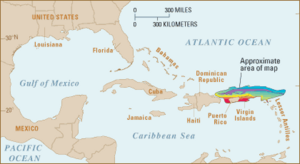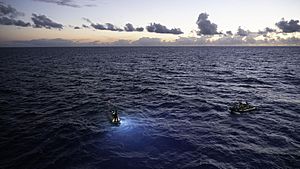Puerto Rico Trench facts for kids

The Puerto Rico Trench is a very deep part of the ocean. It sits between the Caribbean Sea and the Atlantic Ocean. It is the deepest spot in the entire Atlantic Ocean!
This huge underwater trench is about 800 kilometers (500 miles) long. At its deepest point, it goes down 8,376 meters (27,480 feet). That's like stacking more than 20 Empire State Buildings on top of each other! This deepest spot is often called the Milwaukee Deep or Brownson Deep.
Scientists have found that if a big earthquake happens here, it could create a huge tsunami. A tsunami is a giant ocean wave. The island of Puerto Rico, which is very close to the trench, was hit by a damaging tsunami after an earthquake in 1918.
Contents
How the Earth Moves Here
The Puerto Rico Trench is where two giant pieces of the Earth's crust, called tectonic plates, meet. Imagine them like huge puzzle pieces that are always slowly moving. Here, the Caribbean Plate is sliding past the North American Plate.
Sometimes, one plate also slides underneath the other. This process is called subduction. To the southeast, the South American Plate is sliding under the Caribbean Plate. This is why you find active volcanoes in the Lesser Antilles, a chain of islands southeast of Puerto Rico.
Even though Puerto Rico, the United States Virgin Islands, and the Dominican Republic don't have active volcanoes, they are still at risk. They can experience strong earthquakes and tsunamis because of the plate movements in the trench area. The Puerto Rico Trench has caused earthquakes stronger than magnitude 8.0 in the past. It could do so again.
NASA scientists have found something interesting beneath the trench. There's a very dense mass of rock. It's so heavy that it actually pulls on the ocean's surface, making the water dip a little! This dense mass can even affect how accurate navigation tools are.
Learning About the Risks
For a long time, many people living near the trench didn't know much about the risks of earthquakes and tsunamis. Since 1988, the Puerto Rican Seismic Society has worked hard to teach people about these dangers. They want everyone to be ready for a future earthquake.
After the huge tsunami in 2004 that hit many countries, more people in the Caribbean became worried. Local governments started making emergency plans. The United States government has also been studying the problem for years. They are doing more research on earthquakes and setting up tsunami warning systems to keep people safe.
Earthquakes in the Area
The western coast of Puerto Rico was hit by a big earthquake on October 11, 1918. This earthquake also caused a tsunami. The 1918 earthquake happened because of an old fault line near the Mona Passage.
Scientists are concerned because the main part of the Puerto Rico Trench hasn't had a major earthquake in over 200 years. They think it might be due for a big one soon.
Puerto Rico often experiences smaller tremors, which are like mini-earthquakes. This shows that the area is always active. For example, a tremor in 1981 was felt all over the island. Another in 1985 was felt in the towns of Cayey and Salinas.
On January 13, 2014, a magnitude 6.4 earthquake happened north of Puerto Rico. This earthquake was caused by the North American Plate sliding under the Caribbean Plate at the trench.
| Location | Year | M (Magnitude) |
|---|---|---|
| Puerto Rico Trench |
|
|
| Anegada Trough |
|
|
| Mona Canyon |
|
|
| Mona Canyon |
|
|
| Dominican Republic |
|
|
| Dominican Republic |
|
|
| Puerto Rico Trench |
|
|
| Puerto Rico Trench |
|
|
| Muertos Trough |
|
|
Exploring the Deep Trench
Scientists from the USGS (United States Geological Survey) have used special ships to map the entire Puerto Rico Trench. They use something called multibeam bathymetry, which uses sound waves to create detailed maps of the seafloor.
The very bottom of the trench was first visited by a French submarine called Archimède in 1964. Later, in 2012, a robot vehicle explored it. The robot saw many tiny creatures called amphipods swimming around. Some of these amphipods were collected and brought to the surface for study. They were a type of amphipod usually found in very deep trenches in the Pacific Ocean.
The robot also saw two other interesting creatures. One was a soft, dark animal, about 10-20 centimeters (4-8 inches) long. Scientists think it was a sea cucumber. The other was a small crustacean that looked like a tiny crab or shrimp. These sightings might be the deepest ever recorded for these types of animals!
First Human Dive
On December 19, 2018, an American explorer named Victor Vescovo made history. He dived to the deepest point of the Puerto Rico Trench! This made him the first person to reach the bottom of the Atlantic Ocean. He used a special submarine called the Deep-Submergence Vehicle DSV Limiting Factor.
His dive was part of the Five Deeps Expedition. The goal of this expedition was to map and visit the deepest points in all five of the world's oceans. The data collected from these dives will help scientists create better maps of the ocean floor.
See also
 In Spanish: Fosa de Puerto Rico para niños
In Spanish: Fosa de Puerto Rico para niños
- Mariana Trench
- Plate tectonics
- List of oceanic trenches




